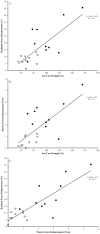Increased residual force enhancement in older adults is associated with a maintenance of eccentric strength
- PMID: 23133544
- PMCID: PMC3479122
- DOI: 10.1371/journal.pone.0048044
Increased residual force enhancement in older adults is associated with a maintenance of eccentric strength
Abstract
Despite an age-related loss of voluntary isometric and concentric strength, muscle strength is well maintained during lengthening muscle actions (i.e., eccentric strength) in old age. Additionally, in younger adults during lengthening of an activated skeletal muscle, the force level observed following the stretch is greater than the isometric force at the same muscle length. This feature is termed residual force enhancement (RFE) and is believed to be a combination of active and passive components of the contractile apparatus. The purpose of this study was to provide an initial assessment of RFE in older adults and utilize aging as a muscle model to explore RFE in a system in which isometric force production is compromised, but structural mechanisms of eccentric strength are well-maintained. Therefore, we hypothesised that older adults will experience greater RFE compared with young adults. Following a reference maximal voluntary isometric contraction (MVC) of the dorsiflexors in 10 young (26.1 ± 2.7 y) and 10 old (76.0 ± 6.5 y) men, an active stretch was performed at 15°/s over a 30° ankle joint excursion ending at the same muscle length as the reference MVCs (40° of plantar flexion). Any additional torque compared with the reference MVC therefore represented RFE. In older men RFE was ~2.5 times greater compared to young. The passive component of force enhancement contributed ~37% and ~20% to total force enhancement, in old and young respectively. The positive association (R(2) = 0.57) between maintained eccentric strength in old age and RFE indicates age-related mechanisms responsible for the maintenance of eccentric strength likely contributed to the observed elevated RFE. Additionally, as indicated by the greater passive force enhancement, these mechanisms may be related to increased muscle series elastic stiffness in old age.
Conflict of interest statement
Figures



Similar articles
-
Modifiability of the history dependence of force through chronic eccentric and concentric biased resistance training.J Appl Physiol (1985). 2019 Mar 1;126(3):647-657. doi: 10.1152/japplphysiol.00928.2018. Epub 2018 Dec 20. J Appl Physiol (1985). 2019. PMID: 30571280 Free PMC article.
-
Residual force enhancement following eccentric induced muscle damage.J Biomech. 2012 Jun 26;45(10):1835-41. doi: 10.1016/j.jbiomech.2012.04.006. Epub 2012 Apr 25. J Biomech. 2012. PMID: 22542219 Clinical Trial.
-
Decay of force transients following active stretch is slower in older than young men: support for a structural mechanism contributing to residual force enhancement in old age.J Biomech. 2014 Oct 17;47(13):3423-7. doi: 10.1016/j.jbiomech.2014.08.026. Epub 2014 Sep 8. J Biomech. 2014. PMID: 25242133
-
Mechanisms of enhanced force production in lengthening (eccentric) muscle contractions.J Appl Physiol (1985). 2014 Jun 1;116(11):1407-17. doi: 10.1152/japplphysiol.00069.2013. Epub 2013 Feb 21. J Appl Physiol (1985). 2014. PMID: 23429875 Review.
-
Preservation of eccentric strength in older adults: Evidence, mechanisms and implications for training and rehabilitation.Exp Gerontol. 2010 Jun;45(6):400-9. doi: 10.1016/j.exger.2010.03.008. Epub 2010 Mar 18. Exp Gerontol. 2010. PMID: 20303404 Free PMC article. Review.
Cited by
-
Residual force enhancement in human skeletal muscles: A systematic review and meta-analysis.J Sport Health Sci. 2022 Jan;11(1):94-103. doi: 10.1016/j.jshs.2021.05.006. Epub 2021 May 29. J Sport Health Sci. 2022. PMID: 34062271 Free PMC article.
-
Enhanced force production in old age is not a far stretch: an investigation of residual force enhancement and muscle architecture.Physiol Rep. 2013 Jun;1(1):e00004. doi: 10.1002/phy2.4. Epub 2013 Jun 7. Physiol Rep. 2013. PMID: 24303098 Free PMC article.
-
The effect of a prior eccentric lowering phase on concentric neuromechanics during multiple joint resistance exercise in older adults.Scand J Med Sci Sports. 2023 Oct;33(10):2009-2024. doi: 10.1111/sms.14435. Epub 2023 Jun 22. Scand J Med Sci Sports. 2023. PMID: 37350104 Free PMC article.
-
Motor unit contributions to activation reduction and torque steadiness following active lengthening: a study of residual torque enhancement.J Neurophysiol. 2020 Jun 1;123(6):2209-2216. doi: 10.1152/jn.00394.2019. Epub 2020 Apr 29. J Neurophysiol. 2020. PMID: 32347154 Free PMC article.
-
Influence of Joint Angle on Residual Force Enhancement in Human Plantar Flexors.Front Physiol. 2017 Apr 24;8:234. doi: 10.3389/fphys.2017.00234. eCollection 2017. Front Physiol. 2017. PMID: 28484395 Free PMC article.
References
-
- Narici MV, Maffulli N (2010) Sarcopenia: characteristics, mechanisms and functional significance. Br Med Bull 95: 139–159. - PubMed
-
- Vandervoort AA (2002) Aging of the human neuromuscular system. Muscle Nerve 25: 17–25. - PubMed
-
- Aagaard P, Suetta C, Caserotti P, Magnusson SP, Kjaer M (2010) Role of the nervous system in sarcopenia and muscle atrophy with aging: strength training as a countermeasure. Scand J Med Sci Sports 20: 49–64. - PubMed
-
- Roos MR, Rice CL, Vandervoort AA (1997) Age-related changes in motor unit function. Muscle Nerve 20: 679–690. - PubMed
Publication types
MeSH terms
LinkOut - more resources
Full Text Sources
Medical

